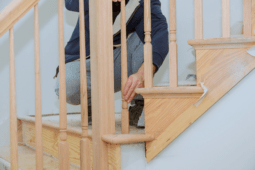Vermiculite Insulation: DIY Safe Asbestos Removal
Vermiculite is a mineral that was once all the rage in building insulation. With a minimum of a half-percent of asbestos, up to 10%, it was considered a perfect fireproofing material. But now that we know the damage asbestos has on our lungs, removing this undesirable building material has become common practice. Vermiculite was still actively used as insulation in home building all the way up to 1990, so it’s worth getting to know the substance and how to remove it.
Over 70% of the vermiculite used in America came from one mine in Montana. That same mine was rich in asbestos which was processed at the same facility. You’ll know it’s vermiculite if it looks like tiny little stones all along your attic floor or in the walls.

Test The Vermiculite
This is the extreme edge of construction or deconstruction for the homeowner. You must test the content of this material first before you work with it. If it tests above one-percent asbestos, it is time to call in the professionals.
If it tests below one-percent, and none of it ever tests below half-a-percent, then you as a homeowner can remove it yourself. Anything above 1%, call in a professional immediately.

How To Remove Vermiculite Yourself
There are few absolutes before we get started. You must wear a full-face cartridge-style mask. A standard dust mask or N95 won’t do the job. Get one that looks like it came off a World War I battlefield after a poison gas attack. If vermiculite gets in your lungs it cannot be removed.
Next, be sure to never work with dry vermiculite. You should moisten it before you begin, and add a mist of water constantly as you begin to remove layers of it. Just think, if you tried to sweep up dust it flies into the air. But mopping it up ensures it stays put and is easy to remove.
A large shop vacuum works best in attics. Line the shop vac with heavy-gauge plastic bags and start sucking up the vermiculite. Each bag should be securely closed, taken to a storage area, and labeled. You’ll need to call your local landfill to see the regulations on vermiculite transportation and storage. Most will take it if it is under the one-percent asbestos threshold.
Your best friend as the vermiculite spills, and it will, is a scoop shovel and a soft broom. Sweeping with a heavy bristled broom just increases the vermiculite (and asbestos) dust in the air, something you must avoid.

Removing From A Wall Vs. Roof
When it’s out of the roof, you can replace it with blow-in fiberglass insulation, or bats of fiberglass insulation in pre-cut widths.
Walls are another story. If the vermiculate is packed inside a wall, you can often drill a hole between each set of studs at the bottom of the wall on the outside with a hole saw. Most of the vermiculate will fall out of the hole and directly into buckets or bags if you’re careful. A shop vac shoved into the hole takes care of the rest. You can fill the wall back up with foam insulation, but that usually requires a professional, with professional-grade equipment.

Disposing of Vermiculite
Once it’s all been removed, you’ll need to transport it to a sanctioned landfill. Many landfills require you to transport it inside a covered trailer with heavy plastic bags properly labeled and sealed.

This is a job you can do yourself, but it’s usually done by professional asbestos abatement crews, and it is not cheap. You may be able to recover some of your expenses with an application to the Zonolite Attic Insulation Trust. Zonolite is the company that produced this stuff originally. The trust will pay up to 55 percent of the removal cost with a maximum payment of $4,125. You can learn more about the program at zonoliteatticinsulation.com
At the end of the day, make sure you stay safe and remove this harmful substance if you find it.









